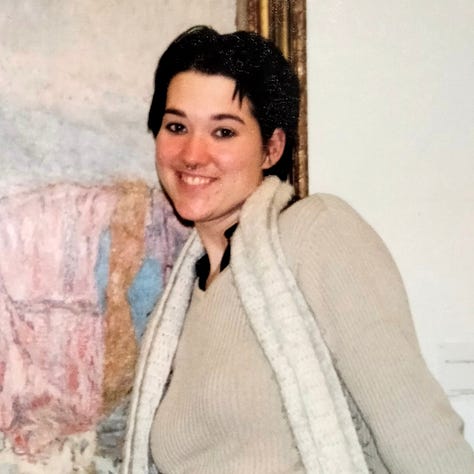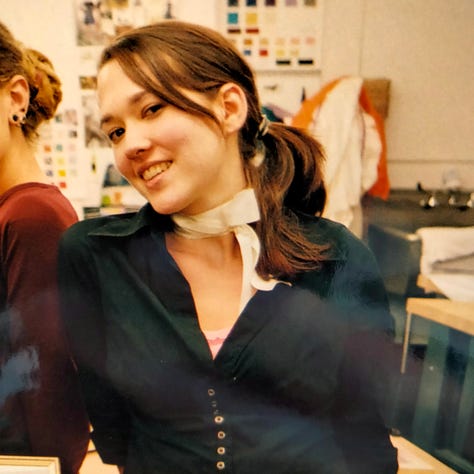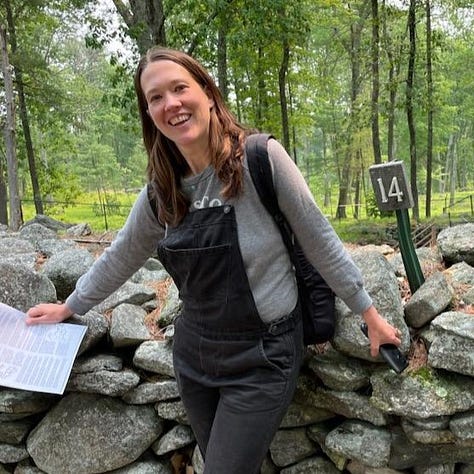This essay was adapted from a talk I gave on the Recovery Panel during the Macrobiotic Winter Conference presented by Planetary Health on 1/11/24.
My name is Christin Ritz. I started macrobiotics in 2004, almost 20 years ago. In order to put this story together, I had to really dig deep into my memories and think back to that time when I was just 23 years old, now almost half my lifetime, to remember what I was eating then and the issues I was experiencing.
First, I have to acknowledge where I was coming from. I grew up during the 80s and 90s. I don’t think my family’s diet was unusual. We ate meat and dairy multiple times a day. Probably half our vegetables were canned, and we relied on a lot of instant foods like Kraft Mac & Cheese, Hamburger Helper, things like that. I drank soda, ate sweets, and had plenty of sugar in my diet. When I was in middle school, my dad got a small deep fryer, so french fries and fried chicken became a frequent part of our meals as he attempted to create the perfect fry batter. (He eventually succeeded!)
Overall I was considered a healthy kid because I had no serious problems, and the problems I did have were accepted as normal by my family and pediatrician. For example, I constantly had colds, a runny nose, sore throats and earaches. As soon as I got over one, another would start. I have a memory of my grandmother scolding my mom, saying “What’s wrong with this kid? Why is she always sick?” My mom didn’t have an answer for her. I stood there shocked that my runny nose was something to be upset about.
As I got older I experienced skin rashes that would come and go. My dad had the same issue, something like psoriasis, and he told me there was nothing to do about it. I had extremely dry skin, especially my hands in the winter. Several times while sitting at my desk at school my knuckles would start bleeding when my skin would break open from the dryness.
Later on in my teens I was getting fungal rashes that were so itchy they could drive you mad. I was given prescription creams for them. They would pass but always return. Then, in my early 20s I had a new skin issue called molluscum. They form in groups and look sort of like a pimple, but are hard and can grow quite large. The only thing the doctor could offer me was to burn them off, which I did once, but since they kept appearing that wasn’t a sustainable solution.
Saying this all back now, it seems funny I thought of myself as being in “good health,” but I did because none of these chronic issues kept me from school or work, and the people around me found them to be fairly average. I believed that I was a random victim of these afflictions and that I would have to live with them.
As a kid, vegetarians always intrigued me. I didn’t know any, but the idea of unconventional people who didn’t conform to society because of their moral code of kindness and dedication to health had a really interesting appeal. This was in my tween years, and my parents didn’t support this at all as meat was a mainstay of our diet, so it wasn’t until I was almost 20 that I gave up eating meat. That led to a year or two of being vegan. I was what I now refer to as a “barbeque potato chip vegan.” I couldn’t cook and knew nothing about nutrition, so if something was vegan, I ate it, no matter if it was processed junk food.
When I moved out on my own, I got some vegetarian cookbooks from the library and started to get more interested in nutrition and health. Eventually I ended up attending a weekly macrobiotic cooking class at someone’s house where a small community of people met on Wednesday nights to learn cooking techniques, philosophy, and eat together. Many were there in hopes of improving a serious illness or health condition. I wasn’t there to resolve any of my issues. It never occurred to me that food had anything to do with them. I was young and in “good health.” I kept going every week because like the vegetarians of my childhood, the macrobiotic people and their philosophy of yin and yang intrigued me.
So when I began, I had already given up meat, dairy and eggs. Starting macrobiotics just meant giving up sugar and tropical fruits, and starting to eat brown rice, beans, fresh vegetables, seaweed, and miso.
My skin rashes largely improved. I didn’t notice right away, because they always came and went, but after a while they stopped coming. I found the notes from my first macrobiotic consultation, which was nine months after I started going to cooking class. I wrote that the molluscum had stopped growing in size and number, but were still there. I was advised to avoid dense proteins like seitan, tempeh, and the fried tofu I had been having at the Chinese restaurant every week. These had become some of my favorite foods! I was also to avoid baked flour and limit oils. It was suggested I eat mochi and drink apple juice as well as amasake to help soften tightness. For a topical skin remedy, I could make a paste from the grain Hato Mugi.
Today I look at that advice and see that after a life of eating a lot of deep fried animal foods, I had simply replaced them with plant based versions that had the same dense, oily qualities. The counselor was directing me away from the energy of the foods I had grown up eating in excess that were causing my current problem. I followed his advice for about six months and the molluscum disappeared and never has returned.
Another nine months after that, I went back for a second consultation when a fungal skin rash began on my hands. It was horribly uncomfortable as it spread to my breasts, stomach, and legs. I had also been diagnosed with HPV (human papilloma virus) by my gynecologist. This time the suggestions were different.
I was told to have no raw salad, fruit, or barley malt (the grain-based sweetener used in macrobiotic cooking). Limit liquid intake, especially coffee, and stop having peanut butter (which I ate a lot of). He suggested I increase the amount of grain in my diet, have salty homemade pickles aged no less than 5 days, stronger miso, and increase the salt ratio in my gomascio (a sesame seed and sea salt condiment). I was to have an umeboshi plum every day for 10 days and drink a medicinal kuzu tea with shoyu sauce. I also took short salt water baths.
Now in retrospect looking at this advice, I can see all the salt, the strong pickles, the umeboshi, along with eliminating fruits and sweets, was all very yangizing. I was now going back in the other direction from the lighter, more yin diet suggestions he had given me previously. These yang foods though, were very different than the yang foods I grew up eating, like fried chicken and hamburger.
My rash did clear up. I have never had another fungal rash in 19 years. Also the HPV disappeared in a month or two and never caused me a problem.
What I want to share much more than the specifics of my healing diet, is that sometimes the path to health isn’t a straight line. It isn’t always as simple as going from one way of eating to another. The trail often has switchbacks. When grains, beans, and vegetables became the foundation of my diet, I gained a sense of balance in my body that I never had before. When I was eating the Standard American Diet, I was incapable of having the intuitive knowledge that I was getting out of whack because I was swinging back and forth between extremes. Without the guidance I received in my consultations, I wouldn’t have known how to correct my problems. Now after years of practice, I can discern the differences of having gone too far in either direction, and for the most part I know what I need to change in order to get back to center. The Latin for “medi” means middle, so I think of “medicine” as something to bring you back to the middle, and for me, medicine is food.
It is important to be flexible, open to change, and not use the advice from one consultation for the rest of your life, because your body will respond and change. Outside of the few months after my consultations when I was treating specific ailments, I have never been rigid with my diet. It is not unusual for me to indulge in foods from the “avoid list.” Recently in a macrobiotic forum I heard someone say, “’Strict macrobiotics’ is an oxymoron.” I agree that we need to eat a wide, varied diet, but no matter how far I may roam, a foundation of whole grains and vegetables is always home. For nearly two decades, I have eaten them almost every day.
Nowadays, I think of food and health like drops of water in a river. At age 23, my river was taking me in a certain direction. The river was all the food and medicines I’d taken up until that point. I was having more and more symptoms, indicative that the river was taking me somewhere I didn’t want to go. When I eliminated certain foods, I stopped adding to the current that was sweeping me away. The new foods and remedies I added to my diet were drops of water moving in the opposite direction, small but powerful. If I went back to my old foods, I was adding drops of water going the wrong way. But eventually I added enough drops to reverse the current of the river all together. The knowledge of how to make balance is like having a paddle, and I have never gotten swept back into the waters I struggled in. Depending on how fast the current of your river is moving, you can heal yourself as fast or as slow as you want to. The drops you add are up to you.






